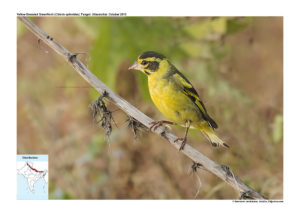Yellow-breasted Greenfinch

Yellow-breasted Greenfinch Carduelis spinoides
Etymology:
- Carduelis : Latin word for the European goldfinch
- Spinoides : Greek word Oides – Resembling, specific name Fringilla spinus (Eurasian Siskin )
Distribution in India: Resident of Himalayas and North East India.
Description: Size of 13-14 cm; wt. of 15–20·8 g. It is a medium-sized finch with conical bill, bright yellow wing bars and notched tail. The male nominate race has top of head black or blackish-olive, sometimes finely spotted yellowish on lower forehead, narrow collar of bright yellow across nape to side of neck, sometimes interrupted by blackish-olive band on central nape; lores and supercilium bright yellow, broad yellow subocular crescent, and broad yellow submoustachial stripe contrasting with blackish-olive malar, rest of cheek and ear-coverts as crown or slightly darker; upperparts mostly blackish-olive, lower back dull yellow, becoming bright yellow on rump and uppertail-coverts; tail dark brown or blackish-brown, edged bright yellow at bases; lesser and median upperwing-coverts bright yellow, greaters black, broadly tipped bright yellow; alula black, finely edged bright yellow, primary coverts and flight-feathers black, bright yellow bases of primaries and outer secondaries, tertials broadly tipped greyish-white; below, almost entirely bright yellow, with greenish tinge on side of breast and flanks, underwing-coverts similar or slightly paler; iris blackish; bill brown to brownish-pink, dark tip of upper mandible, paler or pinkish tip of on lower mandible; legs pinkish or pinkish-brown. Female is very similar to male in plumage pattern, but duller, and nape to upper back and scapulars dark olive and indistinctly streaked blackish, yellow areas in wing and tail less extensive, underparts paler yellow, with smudged streaks across breast, and flanks tinged brownish. The juvenile has pale buffish-yellow head to nape and underparts streaked browner, lores are dark grey, cheeks and ear-coverts are plain buff-brown, mantle, back and scapulars are light buff-brown, streaked darker, median upperwing-coverts are dark brown, broadly fringed pale yellow, and greater coverts are broadly tipped yellow. The first-winter male is more yellow on underparts and extensively on wings than first-winter female. The Nominate race is found in North India, race heinrichi (North East India) is darker than nominate, male with crown and ear-coverts as black, lacking yellow subocular crescent, submoustachial stripe and side of neck, has yellow supercilium.
Habitat: It is found in Submontane and montane open forests also in grassy slopes and open or terraced hillsides and edges of cultivation, scrub and gardens, often above tree-line; occurs at 1600–4400 m in Himalayas.
Food Habits: It eats variety of seeds, other herbs, ripening seed heads of sunflowers and seeds of hemp, millet, rice, buckwheat, also some berries; also eats some small insects. It forages in vegetation, clinging to stems and seed heads of tall plants; also perches in bushes and tall trees, including at tops of pines and alders. It is Gregarious, often in small flocks, also in pairs.
Breeding Habits: They breed in May-Aug in India. They are monogamous. Courtship and display include slow-motion, stiff-winged flight over nesting are. The nest is built entirely by female. The nest is a neat cup of plant fibers and stems, grass, moss and lichens, placed above ground and concealed in overhanging foliage at end of branch, usually of pine or deodar. It lays a clutch of 3–5 eggs. The incubation period is 13–14 days. The chicks fed and cared for by both parents. The nestling period is 13–14 days and the fledglings dependent on parents for a further week after leaving nest.